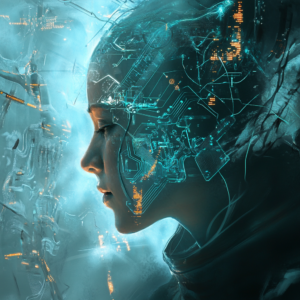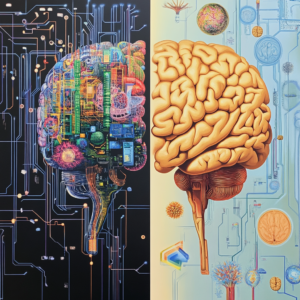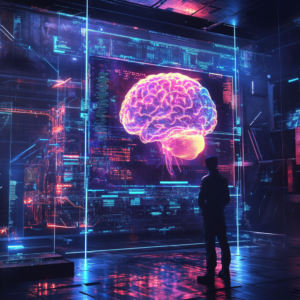1. Introduction
Welcome to my comprehensive exploration of AI vs. Human Intelligence: Exploring the Boundaries. In this article, I share my personal insights and extensive research on the evolving relationship between artificial intelligence and human intelligence. This guide delves into historical developments, defines the core concepts, and presents a detailed comparative analysis of the two. As technology advances rapidly, understanding AI vs. Human Intelligence becomes essential for researchers, industry professionals, and anyone curious about the future of cognition. We will examine how machines process information compared to humans, identify the areas where each excels, and explore the possibilities of synergistic integration.

Setting the Stage
The debate over AI vs. Human Intelligence is more than an academic discussion; it affects everyday decisions in healthcare, finance, education, and creative industries. Innovations in artificial intelligence are transforming industries with speed and precision, while human intelligence brings creativity, empathy, and ethical judgment to complex problems. This article aims to provide you with a balanced view of both, paving the way for informed insights into future trends and potential collaborations between man and machine.
2. Historical Background and Definitions
Early Theories and Pioneers
The journey to understand intelligence has deep roots in philosophical inquiry. Early thinkers such as Aristotle and Descartes explored the nature of human thought, laying the groundwork for later scientific investigations. In the 20th century, pioneers like Alan Turing and John McCarthy advanced the idea of simulating human intelligence with machines. Their groundbreaking work in computer science established the theoretical foundations for artificial intelligence. These early efforts sparked decades of research that eventually evolved into the sophisticated systems we see today.
Evolution of Definitions
Over time, definitions of intelligence have expanded. Human intelligence was initially seen as the ability to solve problems and adapt to new situations. As computers entered the scene, artificial intelligence began to be defined as the capacity of machines to perform tasks that normally require human cognition. Today, while human intelligence encompasses creativity, emotional nuance, and ethical judgment, artificial intelligence is recognized for its ability to process vast amounts of data rapidly and execute complex algorithms with precision. This evolution is crucial for framing the discussion on AI vs. Human Intelligence in modern contexts.
The Convergence of Ideas
The convergence between human and machine intelligence has been a subject of ongoing debate. Researchers continue to explore whether AI can ever fully replicate the depth of human thought. This historical context sets the stage for our examination of how far we have come and what future integrations might look like.
3. Defining Artificial Intelligence
Evolution of AI Systems
Artificial intelligence has transformed dramatically since its inception. Early AI systems were rule‑based and could only execute simple, predefined tasks. Over time, the development of machine learning and deep learning techniques enabled AI systems to learn from data and improve over time. This progression has allowed AI to tackle more complex challenges such as natural language processing, image recognition, and autonomous decision‑making.
Core Components and Technologies
Key components of modern AI include neural networks, algorithms that mimic the structure of the human brain, and big data analytics. These systems employ techniques like supervised and unsupervised learning to adapt to new data inputs. As a result, AI can perform tasks with increasing sophistication, sometimes even surpassing human capabilities in areas like pattern recognition and predictive analytics.
Real‑World Applications
AI is transforming industries by powering applications that require rapid data processing and precise execution. For example, AI-driven diagnostic tools in healthcare can analyze medical images with remarkable accuracy, while financial institutions use AI for fraud detection and risk assessment. To explore how these advanced systems are applied in practical scenarios, please visit CNET’s AI section.
Expanding Horizons
In recent years, AI has also begun to venture into creative fields such as music composition, art generation, and even writing. These applications demonstrate the versatility of artificial intelligence and highlight its growing influence in areas once thought to be uniquely human.
4. Understanding Human Intelligence
Cognitive Abilities and Learning
Human intelligence is complex and multi-dimensional. It encompasses abilities such as reasoning, problem-solving, memory, and learning. Our cognitive processes allow us to absorb new information, adapt to changing environments, and generate innovative ideas. Unlike AI, human learning is influenced by experiences, emotions, and social interactions, making it deeply contextual and inherently flexible.
Emotional and Social Dimensions
Emotional intelligence—our ability to understand and manage emotions—plays a significant role in decision-making and interpersonal relationships. Social intelligence, which includes empathy and effective communication, further distinguishes human cognition from artificial systems. These dimensions are critical in scenarios that require ethical judgment and creative problem-solving, areas where AI still faces limitations.
Adaptability and Creativity
Human intelligence is uniquely adaptive; people are capable of learning from diverse experiences and thinking abstractly. This creativity allows for innovative solutions in complex, uncertain situations. It is this blend of analytical and creative thought that sets human intelligence apart and continues to be a benchmark in discussions comparing AI vs. Human Intelligence.
The Human Touch
Despite the impressive capabilities of AI, the human touch remains irreplaceable. Intuition, emotional sensitivity, and moral judgment are aspects of human intelligence that machines have yet to replicate fully. Understanding these strengths is vital as we consider the interplay between artificial and human cognition.
5. Comparative Analysis: Strengths and Limitations
Strengths of Artificial Intelligence
AI excels in areas such as data processing, consistency, and speed. Machines can analyze enormous datasets without fatigue and are capable of performing repetitive tasks with a high degree of accuracy. These qualities make AI indispensable in fields that require rapid decision-making and pattern recognition, such as financial modeling and diagnostic imaging.
Limitations of AI
Despite its impressive computational power, AI struggles with contextual understanding, common sense, and the nuanced interpretation of complex social scenarios. Its reliance on high-quality data means that poor data can lead to significant errors. These limitations highlight the challenges of replicating human-like intelligence in machines.
Advantages of Human Intelligence
Humans possess the ability to think creatively, adapt to unforeseen challenges, and understand the emotional nuances of social interactions. This enables us to solve problems in innovative ways and navigate complex ethical landscapes. Human intelligence thrives in environments that require flexible thinking and empathy, qualities that are difficult to quantify or replicate algorithmically.
Areas for Synergy
The comparison between AI and human intelligence is not about which is superior but rather how they can complement each other. Collaborative approaches that integrate the precision of AI with the intuition and ethical judgment of humans hold tremendous promise for advancing technology and solving complex problems.

6. Applications in Various Domains
Healthcare
In the medical field, AI systems can process and analyze patient data rapidly, leading to quicker diagnoses and personalized treatment plans. However, the empathetic care provided by human doctors is essential for patient trust and recovery. This synergy between machine efficiency and human compassion is a prime example of AI vs. Human Intelligence in action.
Education
AI-powered adaptive learning platforms personalize educational content based on individual student needs, while teachers provide guidance, mentorship, and emotional support. The integration of these two forms of intelligence enhances learning outcomes and fosters a more dynamic educational environment.
Business
Businesses leverage AI to analyze market trends, automate routine tasks, and forecast outcomes with high precision. Meanwhile, human ingenuity drives innovation, strategic planning, and complex decision-making. This collaborative approach improves overall efficiency and competitive advantage.
Creative Industries
In creative fields, AI assists in generating ideas and identifying trends, yet human creativity remains the core driver of innovation. Artists, writers, and designers often use AI as a tool to expand their creative possibilities, blending algorithmic efficiency with human originality.
Scientific Research
AI is revolutionizing scientific research by processing large datasets, modeling complex systems, and identifying patterns that might elude human observation. In tandem, human researchers provide critical interpretation, hypothesis formulation, and ethical oversight. This combination accelerates discovery and drives innovation.
For more detailed insights on applications, explore TechCrunch’s Innovation section.
7. Ethical and Societal Implications
Privacy and Data Security
The extensive use of AI in daily life raises significant privacy concerns. Large-scale data collection and processing by AI systems necessitate robust data protection measures. Ensuring transparency in how data is used and safeguarded is essential to maintaining public trust.
Bias and Fairness
One of the challenges in AI development is addressing inherent biases in training data. These biases can lead to discriminatory outcomes if not properly managed. Continuous human oversight and the development of ethical AI frameworks are necessary to mitigate these risks.
Accountability in Automated Decision-Making
As AI systems take on more complex roles in decision-making, it becomes increasingly important to establish accountability. Clear regulatory guidelines and transparent algorithms are needed to determine responsibility for decisions made by automated systems.
Societal Impact
The integration of AI into various sectors affects employment, education, and social dynamics. The potential for job displacement is a critical concern, and measures must be taken to ensure that technological advancements benefit society as a whole. Ethical considerations and social responsibility are key to balancing progress and protecting human interests.
8. Future Prospects and Research Directions
Innovations on the Horizon
Researchers are exploring groundbreaking technologies such as quantum computing, neuromorphic chips, and advanced neural networks. These innovations promise to further blur the boundaries between artificial and human intelligence, leading to systems that can learn, reason, and adapt in increasingly human-like ways.
Collaborative Human-AI Systems
The future may witness a more seamless integration between AI and human decision-making processes. Systems that combine the analytical power of AI with human intuition and ethical judgment could revolutionize industries, leading to more innovative solutions and improved outcomes.

Investment in Research
Both public and private sectors are investing heavily in AI and cognitive science research. This surge in funding is accelerating technological breakthroughs and driving the development of next-generation intelligent systems. Continued investment in research is crucial to overcoming the limitations of current AI systems and unlocking their full potential.
Addressing Emerging Challenges
Despite promising advancements, significant challenges remain. Ethical issues, data privacy, and algorithmic bias must be addressed to ensure that AI technologies are used responsibly. Transparent regulatory frameworks and ongoing public discourse are vital to navigating these challenges.
For more insights on emerging research directions, visit TechCrunch.
9. Internal and External Resources
Throughout this article, I have integrated insights from various related topics on VikingBytes.com. For further reading on technological innovations and comprehensive reviews, please explore our articles on How AI is Revolutionizing Tech: Trends and Innovations and AI in Everyday Life: Practical Applications You Need to Know. Additionally, external sources such as CNET Tech, Tom’s Hardware, and Wired offer expert opinions and detailed analyses on the latest advancements. I also recommend watching the YouTube video “AI vs. Human Intelligence: Exploring the Boundaries” for a visual guide that complements this article.
10. Frequently Asked Questions (FAQ)
Q1: What distinguishes artificial intelligence from human intelligence?
A: Artificial intelligence excels at processing data and identifying patterns, whereas human intelligence encompasses creativity, emotional depth, and ethical reasoning.
Q2: How do AI systems enhance decision-making processes?
A: AI systems analyze large datasets in real time to provide actionable insights; however, they may lack the nuanced judgment that human cognition offers.
Q3: In which domains do AI and human intelligence collaborate effectively?
A: In healthcare, AI aids in diagnostics while doctors provide care; in business, AI handles data analytics while humans develop strategies; and in creative industries, AI supports ideation alongside human creativity.
Q4: What ethical concerns arise from integrating AI into everyday life?
A: Key issues include privacy, algorithmic bias, and accountability, all of which require careful human oversight and robust ethical frameworks.
Q5: How can society prepare for future challenges at the intersection of AI and human intelligence?
A: Continuous research, transparent regulatory measures, and collaborative systems that blend AI capabilities with human intuition are essential to address emerging challenges.
11. Conclusion
Summary of Key Points
In conclusion, the exploration of AI vs. Human Intelligence: Exploring the Boundaries reveals a complex interplay between the computational power of machines and the creative, adaptive abilities of humans. This guide has traced historical developments, defined core concepts, compared strengths and limitations, and examined real-world applications and ethical implications. These insights are crucial for understanding how AI and human intelligence can complement each other and pave the way for future innovations.
Final Thoughts
As we look to the future, the boundaries between artificial and human intelligence will continue to blur, fostering new opportunities for collaboration and innovation. Embracing this evolution is essential for progress in every field. Thank you for reading this comprehensive guide on AI vs. Human Intelligence: Exploring the Boundaries.
12. Calls to Action and Affiliate Recommendations
If you’re ready to take your AI experience to the next level, I invite you to check out this tool that helps you create content by easily creating realistic digital models of people from simple descriptions and exploring the potential of artificial intelligence in digital art. Check it out here.
